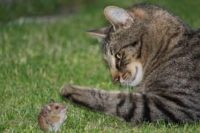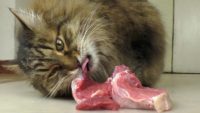Gut Feeling
Everyone who seeks my services finds out pretty quickly what I think about how to feed cats and dogs most appropriately. Whilst I am not wavering from my preference to educate clients about species appropriate diets and specifically raw meaty bones feeding for carnivores, I have reason to ponder some problems we still encounter with this approach. It is clear that certain adjustments need to be made under certain circumstances.
Over the years, dogs themselves have also been helping me to understand that the theoretically most sensible evolutionary approach may not work for all cases all the time. Cats generally fare better.
After considering why this may be so, I am reminded that many of the dogs presenting to me with gut issues are products of genetics gone awry for many generations of purebreeding. The most popular dog breeds in this country have long been German Shepherds, Golden Retrievers and Labrador Retrievers or their crosses. The most commonly presented dogs I have for recurrent gut issues are the same list on the whole and includes Boxers and Rottweilers. Other popular breeds like Staffordshires, Maltese and other small terriers have skin issues predominantly although diet plays a major role in fixing all health conditions in all dogs as discussed in detail elsewhere.
Common signs of gut issues that can be missed include
-restlessness or anxiety
-constant licking or tongue movements in the air or gulping
-looking depressed or lacking enthusiasm
-tucked up or prayer positioning
These signs are likely to be related to pain and are generally less alarming than the more obvious signs of vomiting, diarrhoea, bloating or gas production. It is also pertinent to remember that both the liver and pancreas are organs of digestion and treatment plans must include support for these.
This posting focuses on exploring and unpacking some of the reasons for why the best diets can sometimes be inadequate in some cases.
I have already alluded to what I consider to be the most likely reason that dogs being fed raw meaty bones diets still have some difficulties in adapting to this diet;
Genetics
Our dogs have co-evolved with humans over thousands of years and over the past few decades especially have been transitioned onto artificial diets as have we ourselves for much the same reasons. Even though there are no obvious changes in their physiological functioning and their need to eat prey, I do believe they have lost some digestive capacity in much the same way that they have lost it in other areas due to the same influences of selective breeding and poorer nutrition.
It does not take long to change the microbiota or to inhibit enzyme production or adapt to carbohydrate laden foods but it can take some time to reverse this problem.
It is also nigh on impossible to accurately replicate the wholefood natural diet a dog would have in the wild since it would be foraging and eating what it has hunted. Our recipes are at best an attempt to mimic these ratios.
Most dogs I see transition very well and quickly back to better health once they switch to raw diets but some will have difficulties digesting bones in any quantity or even in feeling comfortable after eating them. Another possibility is the inability to digest increased amounts of raw fat, which whilst being an essential dietary component can also overwhelm an unprimed system. Perhaps we also have to remember to respect digestion more too as it is normal to rest and digest after a meal; another function that has diminished in modern stressful times.

They also would have had the fur feather and skin to enable the gut to package the bone material and if you look closely at wild dog or carnivore scats (stools) you may notice they may be covered in fur from their meal. In domestic dogs this is often replaced by a mucous layer, which may alarm some vigilant owners but is a normal mechanism for replacing the lost packaging ingredients and for protecting the gut lining from potential damage.

We are primed to expect that since these disorders in our pets are termed genetic predispositions that they cannot be changed but if we can encourage breeders to feed evolutionary diets the future offspring will most likely be better prepared. This is frustrating for owners who want the benefits of this program to be enjoyed by their dogs immediately but for the few, for which this post was written, there needs to be some adjustments made to the feeding practice to help dogs adjust to years of bad diets in their bloodlines.
Ingesting irritants or toxins
For similar reasons it can be helpful to feed cooked chicken, rice and yoghurt to settle any upsets from a variety of causes such as surgery or extreme disruptions to the gut from toxins or dietary indiscretions that cause repeated diarrhea, discomfort or vomiting. I have been prescribing this for over thirty years and it is encouraging to see that this is still recommended by younger vets as a treatment option.
Toxins include the saturation of our food chain with herbicides and chemicals that cause serious disruption to bacteria in our gut and a host of other metabolic disturbances still to be investigated. Admittedly these poisons will be present in both cooked and raw diets of both meat and vegetables. Organically grown foods can be difficult to obtain and I encourage my clients to grow their own vegetables and greens if possible.
Advanced age or infirmity
I also believe that older or very ill dogs with cancer or advanced disease can do better on homemade cooked diets for a while or even for the duration of their life given that these dogs would already have died if they lived in the wild.
In simplified terms it appears that whilst raw foods confer more energy and strength to a system they can also require more energy to digest. Dogs that repeatedly exhibit pain or discomfort after raw foods may require digestive enzymes or remedies to assist adaptation and some just need cooked foods. Others will outright refuse to eat raw meaty bones though these are also rare exceptions once they have tried them. Ironically cats can be far harder to transition to raw foods but after their food is warmed up a bit and looks and smells more like prey they will usually have their instincts rekindled.

I also now recommend feeding one or the other of cooked or raw foods and to try to avoid mixing them together since there are different digestive processes involved in each. We are currently experimenting with alternate weeks or one in four in cases that require cooked foods for interim therapy.
Given that we should never feed them cooked bones or cooked fat, cooked diets will be nutrient and energy deficient without the addition of bone broth or other calcium sources as well as adding another source of energy. Usually the animals requiring these cooked foods can do well enough without the extra energy source since their requirements are generally lower.
Raw foods will have more energy from the raw fats and unless carbohydrates are added to cooked foods which is one of the main ingredients we wish to minimize for dogs and cats, there will be insufficient calories to maintain exercise.
By the way, I completely empathise with people who find feeding animals to animals a little grotesque. As we become more sensitive and aware of the beauty of all things it can be increasingly difficult for us to cope with the vulgarity of animals eating others. It is not hard to see why it is easy to sell food for pets in bags and tins to avoid us having to confront these issues for animals, however once we appreciate that the natural world has its own set of conditions and laws it is easier to accept that our pets, like ourselves, have to eat. We may be more spiritually aware and follow a vegetarian diet but they belong to the animal world and it is their birthright to evolve in their own way. Unfortunately we just also have to dig deep and provide things they can no longer procure for themselves in domestic situations. I also hate it when my cat kills and eats the birds in my garden but that is what cats do.
It’s Ok to want your pet to be your best friend or companion but remember even though they may be the most loving and loyal creatures you have ever met, they are not human yet.

Sri Chinmoy says………
When we enter into the spiritual life we become fully conscious of our four simultaneous lives. It is only in the spiritual life that we become aware of our animal life, human life, divine life and immortal Life. Before we enter into the spiritual life, these lives are practically unknown to us, simply because we are not conscious of their existence.
What do we mean by the animal life? The animal life is the life of jealousy, doubt and destruction or conscious annihilation. The animal life is like a strong and binding rope. Although the propensity of the animal life is to fight and destroy, there is something in the process of evolution that tries to curb this destructive tendency. That is why from the animal life we enter into a higher form, the human life.
In the human life we still notice a half-animal life. That is to say, we still quarrel, fight, destroy and do many other undivine things. But in the human life we also notice something very meaningful and fruitful, which is called hope. We cherish and treasure an illumining hope. Hope is not something vague and tempting yet millions of miles away from the actual blossoming of reality. No, hope is something that is pushing us forward, pulling us upward to a sublime Reality. Hope is constantly helping us and energising us to run toward the destined Goal.
Excerpt from Sri Chinmoy’s talk
June 25th, 1973
Hörsaal 120
University of Zurich
Zurich, Switzerland
April 19th, 2020 at 11:09 pm
Excellent article including philosophy as well as specifics of food.